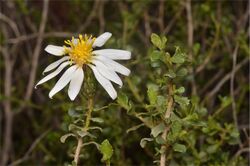Biology:Olearia calcarea
| Limestone daisy bush | |
|---|---|

| |
| Olearia calcarea in the Gawler Ranges | |
| Scientific classification | |
| Kingdom: | Plantae |
| Clade: | Tracheophytes |
| Clade: | Angiosperms |
| Clade: | Eudicots |
| Clade: | Asterids |
| Order: | Asterales |
| Family: | Asteraceae |
| Genus: | Olearia |
| Species: | O. calcarea
|
| Binomial name | |
| Olearia calcarea F.Muell. ex Benth.[1]
| |
| Synonyms[1] | |
|
Aster calcareus (F.Muell. ex Benth.) F.Muell. | |
Olearia calcarea, commonly known as limestone daisy bush,[2] is a species of flowering plant in the family Asteraceae and is endemic to southern continental Australia. It is a shrub with egg-shaped or broadly spoon-shaped leaves with toothed edges, and white and yellow, daisy-like inflorescences.
Description
Olearia calcarea is a shrub that typically grows to a height of up to 80 cm (31 in). It has scattered broadly spoon-shaped to egg-shaped leaves with the narrower end towards the base, 2–15 mm (0.079–0.591 in) long and 2–5 mm (0.079–0.197 in) wide with toothed edges. The leaves are more or less sessile, both surfaces a similar colour. The heads are arranged singly on the ends of branchlets and are more or less sessile and 31–45 mm (1.2–1.8 in) in diameter. Each head or daisy-like "flower" has a bell-shaped involucre 12–18 mm (0.47–0.71 in) long, and eight to twelve ray florets, the petal-like ligule oblong, pale purple to white and 9–15 mm (0.35–0.59 in) long surrounding ten to fifteen yellow disc florets. Flowering occurs from May to October and the fruit is a silky-hairy achene, the pappus with 74 to 84 bristles in two rows.[2][3][4]
Taxonomy
Olearia calcarea was first formally described in 1867 by George Bentham in Flora Australiensis from an unpublished description by Ferdinand von Mueller.[5][6] The specific epithet (calcarea) means "limy", referring to the soil.[7]
Distribution and habitat
Limestone daisy bush grows in on mallee woodland on limestone-rich soils in southern Western Australia, southern South Australia, far north-western Victoria and west of Nymagee in far western New South Wales.[2][4][3][8]
References
- ↑ 1.0 1.1 "Olearia calcarea". Australian Plant Census. https://biodiversity.org.au/nsl/services/apc-format/display/118543.
- ↑ 2.0 2.1 2.2 Lander, Nicholas S.. "Olearia calcarea". Royal Botanic Garden Sydney. https://plantnet.rbgsyd.nsw.gov.au/cgi-bin/NSWfl.pl?page=nswfl&lvl=sp&name=Olearia~calcarea.
- ↑ 3.0 3.1 "Olearia calcarea". State Herbarium of South Australia. http://www.flora.sa.gov.au/cgi-bin/speciesfacts_display.cgi?form=speciesfacts&name=Olearia_calcarea.
- ↑ 4.0 4.1 Walsh, Neville G.; Lnder, Nicholas L.. "Olearia calcarea". Royal Botanic Gardens Victoria. https://vicflora.rbg.vic.gov.au/flora/taxon/ad418eb1-916c-4fef-bc36-201c7ea16d09.
- ↑ "Olearia calcarea". https://biodiversity.org.au/nsl/services/rest/name/apni/532478/api/apni-format. Retrieved 11 March 2022.
- ↑ Bentham, George; von Mueller, Ferdinand (1867). Flora Australiensis. 3. London: Lovell Reeve & Co.. p. 481. https://www.biodiversitylibrary.org/item/41807#page/489/mode/1up. Retrieved 11 March 2022.
- ↑ Sharr, Francis Aubi; George, Alex (2019). Western Australian Plant Names and Their Meanings (3rd ed.). Kardinya, WA: Four Gables Press. p. 154. ISBN 9780958034180.
- ↑ "Olearia calcarea". FloraBase. Western Australian Government Department of Parks and Wildlife. https://florabase.dpaw.wa.gov.au/browse/profile/8129.
Wikidata ☰ Q15585448 entry
 |

